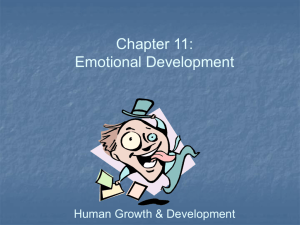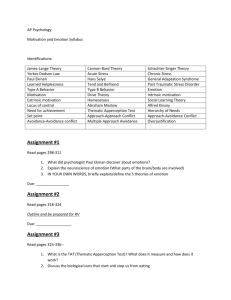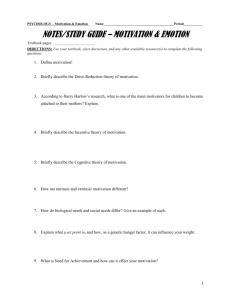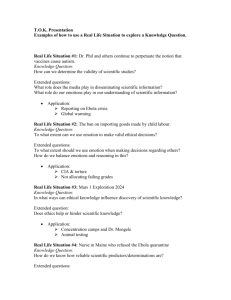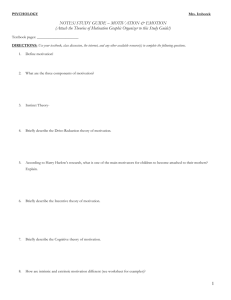Infant Emotion Regulation
advertisement
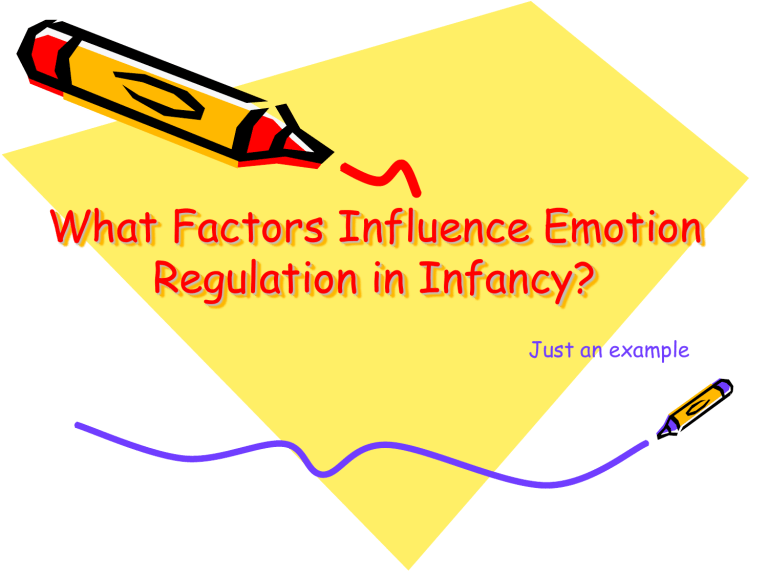
What Factors Influence Emotion Regulation in Infancy? Just an example Abstract • The most common strategies are passive disengagement and physical regulation. • Highly reactive infants show deficiencies in emotion regulation development. • When caregivers are unavailable, infants use more regulation. • Father-infant avoidant attachment is associated with employment of distraction and self-soothing. • Physical stimulation can contribute to the negative emotional state of the infant. What Is Emotion Regulation? • Definition – Intrinsic and extrinsic processes responsible for identifying, supervising, evaluating, and altering emotional reactions (Thompson, 1994). • Function – To manage arousal, control behaviors and reactions, and thereby define and adjust interactions to fit both individual and social demands. – If unable to master the task of emotion regulation, “deleterious emotional arousal and the misleading identification and misdirection of emotions” (Kostuik & Fouts, 2002) can result, possibly leading to socially inappropriate behaviors and a limited ability to adapt to spontaneous experiences. Strategies of Self Emotion Regulation In Infancy Regulation Strategy Mother Face-to-Face Mother Still-Face Mother Reengagement Stranger Face-to-Face Total Self-Soothing 5 11 5 4 25 Scanning 9 7 11 9 36 Passive Disengagement 15 18 20 18 71 Distraction 5 9 2 10 26 Physical 1 14 9 17 41 Total 35 59 47 58 Temperament • Anger and Frustration (Calkins, et al., 2002) – Results • Easily frustrated infants used more physical regulation, scanning, and mother orienting, and less distraction. • In addition, they received lower scores on attention task exercises and were observed to have higher activity levels. – Conclusions • A “lack of focused attention coupled with a tendency to be very active and easily distressed may predispose the child to be unable to exert control over his or her behavior.” (Calkins, et al., 2002) Temperament • Effects of Excessive Crying (Stifter & Spinrad, 2002) – Results • Excessive criers exhibited significantly lower levels of self-regulation even after controlling for negative reactivity. • Higher levels of regulation were associated with less negativity. – Conclusions • Inattention that results from excessive crying inhibits infants’ ability to internalize regulation techniques, hence disturbing emotion regulation development. – Findings supported by Calkins, et al. (2002). Infant-Caregiver Interactions • Parent Availability (Bridges, et al., 1997) – Parent Active • Infants’ negative expression significantly decreased. • Infants’ levels of active engagement increased. – Parent Passive • More physical and self-soothing techniques observed. • Infants utilized more object focus. • Infants’ distress levels significantly higher in mother-passive than in father-passive situations. – Cross parent analysis reveal possible influence of type of parent-infant interaction (caregiver sensitivity (?)) experienced on emotion regulation. Attachment Quality (Diener, et al., 2002) • Infant-Father Attachment – Avoidant Attachment • Distraction and self-soothing most common techniques. – Secure Attachment • Infants exhibited fewer self-soothing behaviors. • Infant-Mother Attachment – No association between attachment quality and emotion regulation strategy found. – Similar to Bridges, et al., implies a role of caregiver interaction type on regulation. Physical Stimulation • Effects of Maternal Touch (Hernstein & Campos, 2001) – Negative Expression • Tension Increase – Infants demonstrated more negative emotional displays. » Less initiation of play. » Decrease duration of play. • Relaxation – Infants exhibited no differences from control infants in initiation or duration of play. – Positive Emotion • No major changes or differences in infants’ disposition for either condition. Summary • The most common methods of emotion regulation in infants at 4 months are passive disengagement and physical strategies. • Highly frustrated infants exhibit deficiencies in emotion regulation development. • Tension increase in physical stimulation via maternal touch increases negativity (regulates emotion) and hence emotion regulation in infants. • The level of emotion regulation necessary and the type of regulation utilized depends on parent availability in stressful situations. • The use of particular regulation techniques is associated with attachment quality in infant-father relationships. References • • • • • • Bridges, Lisa J. (1997). Infant Emotion Regulation with Mothers and Fathers. Infant Behavior and Development 20(1). 47-57. Calkins, Susan D., Dedmon, Susan E., Gill, Kathryn L., Lomax, Laura E., and Johnson, Laura M. Frustration in Infancy: Implications for Emotion Regulation, Physiological Processes, and Temperament. Infancy, 3(2). 175-197. Diener, Marissa L., Mangelsdorf, Sarah C., McHale, Jean L., Frosch, Cynthia A. Infants’ Behavioral Strategies for Emotion Regulation With Fathers and Mothers: Associations With Emotional Expressions and Attachment Quality. Infancy 3(2). 15317. Hertenstein, Mathew J., Campos, Joseph J. (2001). Emotion Regulation via Maternal Touch. Infancy 2(4). 549-566. Stifter, Cynthia A., Spinrad, Tracy L. (2002). The Effect of Excessive Crying on the Development of Emotion Regulation. Infancy 3(2). 133-152. Kostiuk, Lynne M., Fouts, Gregory T. (2002). Understanding of Emotion Regulation in Adolescent Females with Conduct Problems: A Qualitative Analysis. The Qualitative Report 7(1). www.nova.edu/ssss/QR/QR7-1/kostiuk.html

